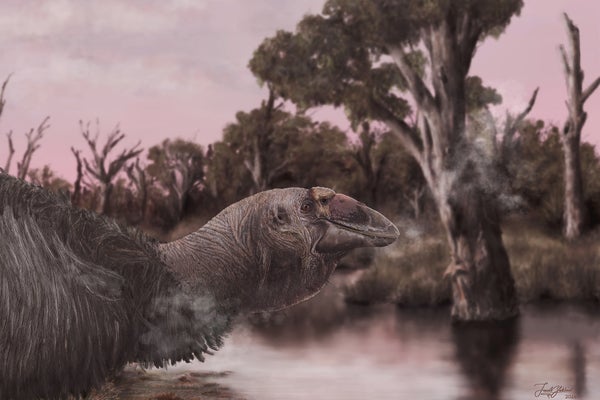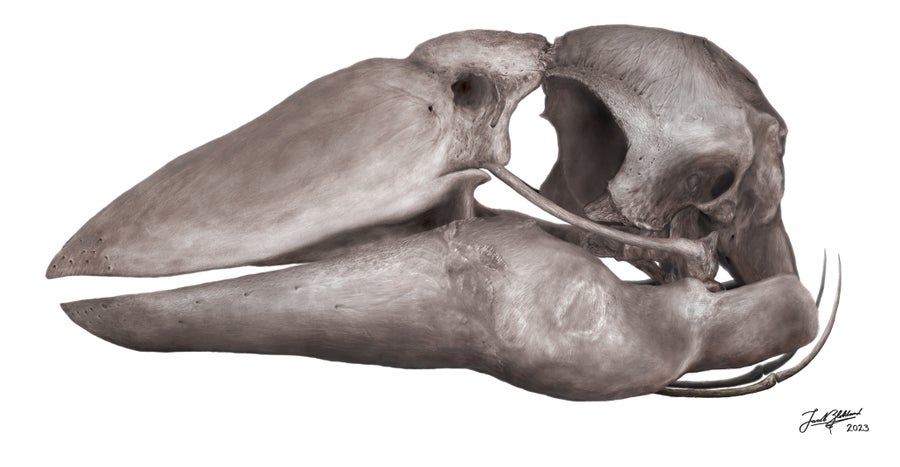500-Pound Prehistoric Bird Was a ‘Giga-Goose,’ Fossils Reveal
Scientists reveal the face of Australia’s massive, extinct “giga-goose”

An artistic life reconstruction of Genyornis newtoni, the last of the dromornithids, at the water’s edge.
Just 50,000 years ago giants roamed the Australian continent—including a wombat relative the size of a rhinoceros, a monitor lizard as long as a crocodile, a heavy-set kangaroo and a “marsupial lion.” And now researchers have uncovered and reconstructed the skull of a 6.5-foot-tall, 500-pound flightless bird that they’ve nicknamed the “giga-goose,” resolving more than a century of speculation about this species’ ancestry.
In 1893 camel-riding palaeontologists dug up a nearly complete skeleton of a massive bird that, tens of thousands of years prior, had gotten itself mired in the mud of Lake Callabonna in South Australia. While its body was remarkably preserved, its fossil skull was “very dodgy”—crumbly, crushed and distorted—says Phoebe McInerney, an evolutionary biologist who recently received a Ph.D. from Flinders University in Australia.
Without a clear picture of its head, many scientists assumed that this bird, called Genyornis newtoni, was a mega version of the emu, an ostrichlike flightless ratite that roams Australia today. Others thought it was a type of land fowl like a chicken. But those were only guesses. All big birds look roughly similar from the neck down, McInerney explains. Regardless of a bird’s evolutionary lineage, “when the body gets large and flightless, all the same things happen,” she says: stumpy wings, a broad rump, bulky legs.
On supporting science journalism
If you’re enjoying this article, consider supporting our award-winning journalism by subscribing. By purchasing a subscription you are helping to ensure the future of impactful stories about the discoveries and ideas shaping our world today.
“The skull is what will retain those more complex family indicators,” McInerney says. “So for the last 120 or so years we have been looking for better skull fossils.”
And now McInerney and her colleagues at Flinders have found them. In a paper published on Monday in Historical Biology, the researchers describe and diagram a complete Genyornis skull, plus a collection of beautifully preserved partial skulls they unearthed at Lake Callabonna between 2013 and 2019. “Seeing the skull fully out of the matrix and free from the dirt around it was definitely a ‘wow’ event,” McInerney says. “We weren’t really sure what to expect, and we kept finding new parts of the skull that were hidden within.”

An artistic reconstruction of the skull of Genyornis newtoni in articulation, based on the fossil material.
The fossils revealed a unique face—quite different from any other living or extinct bird but most similar to a duck or a goose. This suggests Genyornis belongs in the Anseriformes: an order of birds also called waterfowl, ranging from ducks to swans to South America’s screamers.
“There’s no close analogue for these birds” elsewhere in the world, says Nic Rawlence, a paleoecologist at New Zealand’s University of Otago, who was not involved in the research. “They are a truly unique Australian island experiment, as unique as koalas and kangaroos,” he adds. “With this amazing new discovery, we can now actually start to reconstruct the evolution and the behavior of this animal.”
The wide gape, strong bite and muscle attachments of Genyornis’ beak suggest it had fine motor control, leading the researchers to speculate that the bird fed by tearing leaves and fruit from waterside plants. The skull fossils also revealed adaptations for aquatic habitats, such as structures that prevented water from entering the ears—further evidence that this was essentially a gigantic goose that relied on freshwater habitats, McInerney says.
Aboriginal Australians likely encountered Genyornis. Giant birds feature in rock art and stories, and there’s a word for “giant emu” in at least one Aboriginal language.
Some researchers have interpreted fragments of massive burned eggshells as evidence that humans cooked and ate Genyornis eggs, but the identity of the shells remains controversial.
Scientists are also still debating why Australia’s megafauna vanished. When humans arrived on the continent, its once-lush landscape was already drying out. The extinctions may have been triggered by climate change, hunting or a combination of both. Today Lake Callabonna is mostly dry, salty and treeless—no place for a water-loving giga-goose.
